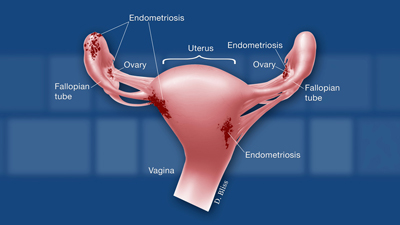Endometriosis is a disease in which tissue similar to the lining of the uterus grows in other places in the body. The tissue may respond and have different features than the uterine lining.
The word endometriosis comes from the word "endometrium" (pronounced en-doh-MEE-tree-uhm)—endo means "inside" and metrium (pronounced MEE-tree-uhm) means "uterus, where a mother carries her baby." Health care providers call the tissue that lines the inside of the uterus the endometrium.
Health care providers may use the terms "implants," "nodules," or "lesions" to describe areas or patches of endometriosis. Most endometriosis patches are found in the pelvic cavity:
- On or under the ovaries
- On the fallopian tubes, which carry egg cells from the ovaries to the uterus
- Behind the uterus
- On the tissues that hold the uterus in place
- On the bowels or bladder
 In rare cases, endometriosis may grow outside the pelvic cavity, such as on the lungs or in other parts of the body.1
In rare cases, endometriosis may grow outside the pelvic cavity, such as on the lungs or in other parts of the body.1
Researchers' understanding of endometriosis is changing as scientific evidence proves and disproves long-held assumptions. For example, researchers used to think that pain from endometriosis was related to the size of the patches growing outside the uterus. But evidence shows that this is not the case. In fact, the size and location of the lesions are not related to the severity of pain or to the location of the pain.2,3 Assessment of quality of life indicates that pain is also not associated with a woman's ability to get pregnant.4,5
How common is endometriosis?
It is difficult to know exactly how many women have endometriosis because some women might have the condition but not the symptoms. In 2011, the NICHD-led Endometriosis: Natural History, Diagnosis, and Outcomes Study found that the number of women with endometriosis varied depending on the population of women being studied and the diagnostic measures that are used.1
The study found that 11% of a group of women who had not been diagnosed with endometriosis actually had the disorder. If this finding applies to all the women in the United States, the number of American women with endometriosis may well exceed previous estimates of 5 million.6
Citations
- Office on Women's Health, U.S. Department of Health and Human Services. (2009). Endometriosis fact sheet. Retrieved December 26, 2011, from http://www.womenshealth.gov/publications/our-publications/fact-sheet/endometriosis.html
- Stratton, P., & Berkley, K. J. (2011). Chronic pelvic pain and endometriosis: Translational evidence of the relationship and implications. Human Reproduction Update, 17(3), 327–346.
- American College of Obstetricians and Gynecologists. (2010, Reaffirmed 2016). Management of endometriosis (Practice Bulletin No. 114). Obstetrics & Gynecology, 116(1), 223–236.
- Santulli, P., Bourdon, M., Presse, M., Gayet, V., Marcellin, L., Prunet, C., et al. (2016). Endometriosis-related infertility: Assisted reproductive technology has no adverse impact on pain or quality-of-life scores. Fertility and Sterility,105(4), 978–987.
- Wilson-Harris, B. M., Nutter, B., & Falcone, T. (2014). Long-term fertility after laparoscopy for endometriosis-associated pelvic pain in young adult women. Journal of Minimally Invasive Gynecology, 21(6), 1061–1066.
- Buck Louis, G. M., Hediger, M. L., Peterson, C. M., Croughan, M., Sundaram, R., Stanford, J., et al. (2011). Estimated incidence of endometriosis by diagnostic method and study population: The ENDO Study. Fertility and Sterility, 96(2), 360–365. Retrieved August 17, 2016, from https://www.ncbi.nlm.nih.gov/pmc/articles/PMC3143230
How many people are affected by or at risk for endometriosis?
What are the symptoms of endometriosis?
How do health care providers diagnose endometriosis?
What are the treatments for endometriosis?


 BACK TO TOP
BACK TO TOP